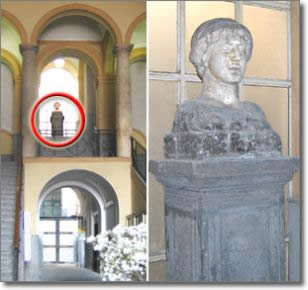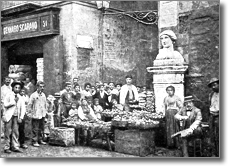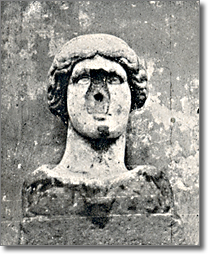Under Parthenope's watchful eye

For the last forty-five years, Parthenope, from her lava pedestal, has been a detached observer of all the people, ideas and hopes that have gathered on the steps of the San Giacomo Building.
Her head, with its quaint, old-fashioned braids pinned up round it, has all the features of a late-Hellenic period statue and since 1594 - the year when certain academics claim it was found in the Anticaglia area - people have believed the marble bust is what remains of an ancient statue of Parthenope.
Although the statue was recognised as portraying the legendary character connected with the founding of the city, it did not save her from the ravages of time or people.
After its discovery, the bust was abandoned to its fate until a Mr. Alessandro Di Miele decided to intervene and displayed it in its full splendour in the street called San Giovanni a mare.

- the statue in the Marina area. Postcard of the beginning of 20th century
At the beginning of XVII century they decided to do restoration work on the bust but the whitewash and varnishes that were used were really thick. Fortunately, all sign of the awful touch-up operation faded with time.
The statue's problems were not over, however. She stood so near Piazza del Mercato that she got caught up in the 1647 Revolution when Spanish soldiers went on the rampage against the rebels, the city and its symbols. The marble head lost its nose and remained noseless until the 1850s when, according to a writer of the period, "it was restored with a false nose, which could have been fashioned a bit more precisely".

- the statue without nose, October 1929
Has already happened fot the plastering of the 17th century, also the rebuilt nose didn't last long and the sculpture shows again its cruelly desfigured face.
During the second world war the Marina area and the near harbour complex
represented an important target for the bombardiers who dropped on the city their burden of death and distruption. Terrible destiny: the ancient statue paid its secular proximity to the harbour's crucial point being damaged again for explosious and collapses.
In 1962 the sculpture, after another restoration and the umptheenth new nose, was placed on the first landing of San Giacomo Palace's main great staircase sheltered from acid rain and smog, but far from the vital heat of that people who nicknamed it "a capa e' Napule" for centuries.
Area Cultura e Turismo Servizio Beni Culturali - Archivio Storico Municipale
Salita Pontenuovo, 31 - 80139 Napoli
e-mail: archivi.storici.biblioteche@comune.napoli.it
pec: archivi.biblioteche@pec.comune.napoli.it